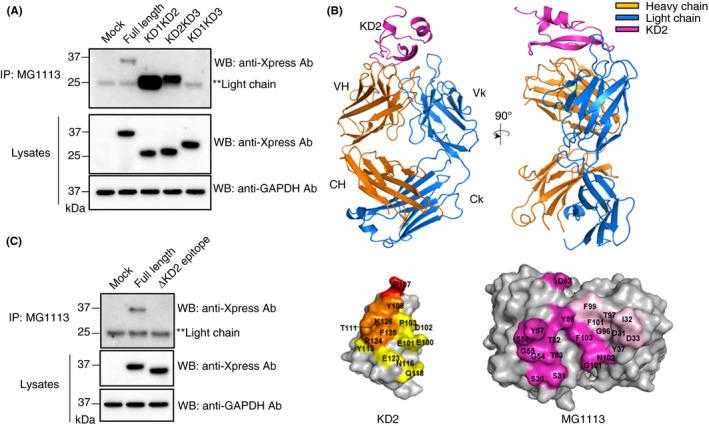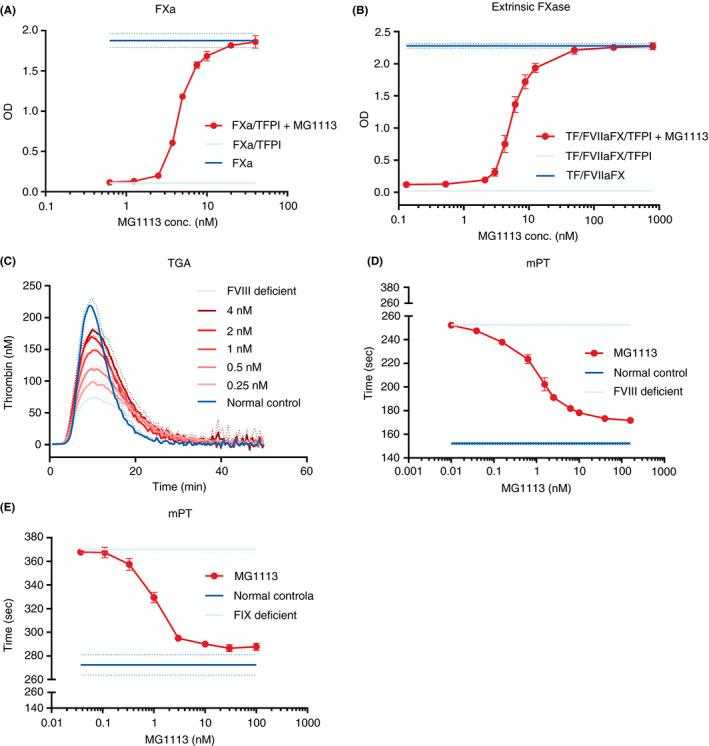Active Recombinant Human TFPI protein, His-tagged
| Cat.No. : | TFPI-875H |
| Product Overview : | Recombinant Human TFPI protein(Asp 29 - Lys 282), fused with His tag, was expressed in HEK293. |
| Availability | December 21, 2025 |
| Unit | |
| Price | |
| Qty |
- Specification
- Gene Information
- Related Products
- Citation
- Download
| Species : | Human |
| Source : | HEK293 |
| Tag : | His |
| Protein Length : | Asp 29 - Lys 282 |
| Form : | Lyophilized from 0.22 μm filtered solution in PBS, pH7.4, 10% trehalose. |
| Bio-activity : | Measured by its ability to inhibit trypsin cleavage of a fluorogenic peptide substrate,Mca-RPKPVE-Nval-WRK(Dnp)-NH2 Fluorogenic MMP Substrate. The IC50 value is <0.50 nM, as measured under the described conditions. |
| Molecular Mass : | This protein carries a polyhistidine tag at the C-terminus.The protein has a calculated MW of 30.0 kDa. The protein migrates as 41-45 kDa under reducing (R) condition (SDS-PAGE) due to glycosylation. |
| Endotoxin : | Less than 1.0 EU per μg by the LAL method. |
| Purity : | >90% as determined by SDS-PAGE. |
| Storage : | For long term, the product should be stored at lyophilized state at -20°C or lower.Please avoid repeated freeze-thaw cycles. This product is stable after at: -20°C to -70°C for 12 months in lyophilized state; -70°C for 3 months under sterile conditions after reconstitution. |
| Reconstitution : | It is recommended that sterile water be added to the vial to prepare a stock solution of 0.2 ug/ul. Centrifuge the vial at 4°C before opening to recover the entire contents. |
| Publications : |
MG1113, a specific anti–tissue factor pathway inhibitor antibody, rebalances the coagulation system and promotes hemostasis in hemophilia (2020)
|
| Gene Name | TFPI tissue factor pathway inhibitor (lipoprotein-associated coagulation inhibitor) [ Homo sapiens ] |
| Official Symbol | TFPI |
| Synonyms | TFPI; tissue factor pathway inhibitor (lipoprotein-associated coagulation inhibitor); LACI; tissue factor pathway inhibitor; EPI; extrinsic pathway inhibitor; TFI; TFPI1; anti-convertin; |
| Gene ID | 7035 |
| mRNA Refseq | NM_001032281 |
| Protein Refseq | NP_001027452 |
| MIM | 152310 |
| UniProt ID | P10646 |
| ◆ Recombinant Proteins | ||
| TFPI-875H | Active Recombinant Human TFPI protein, His-tagged | +Inquiry |
| TFPI-105H | Recombinant Human TFPI protein, His-tagged | +Inquiry |
| Tfpi-9155M | Recombinant Mouse Tfpi Protein, His (Fc)-Avi-tagged | +Inquiry |
| TFPI-707H | Recombinant Human TFPI Protein, MYC/DDK-tagged | +Inquiry |
| TFPI-5070R | Recombinant Rabbit TFPI protein, His-tagged | +Inquiry |
| ◆ Cell & Tissue Lysates | ||
| TFPI-2843MCL | Recombinant Mouse TFPI cell lysate | +Inquiry |
| TFPI-2746HCL | Recombinant Human TFPI cell lysate | +Inquiry |
MG1113, a specific anti–tissue factor pathway inhibitor antibody, rebalances the coagulation system and promotes hemostasis in hemophilia
Journal: Research and Practice in Thrombosis and Haemostasis PubMed ID: 33313469 Data: 2020/10/22
Authors: Heechun Kwak, Sumin Lee, Sung Ho Hwang
Article Snippet:MG1113 and recombinant human (rh) TFPI (Creative BioMart, Shirley, NY, USA) were incubated at 37°C for 10 minutes. rhFXa (Enzyme Research Laboratories, South Bend, IN, USA) was then added and incubated at 37°C for 30 minutes, followed by the addition of FXa substrate, S‐2765 (Instrumentation Laboratory, Bedford, MA, USA).. The absorbance was measured using a VersaMax plate reader (Molecular Devices, San Jose, CA, USA) at 405 nm.The absorbance was measured using a VersaMax plate reader (Molecular Devices, San Jose, CA, USA) at 405 nm.


Neutralizing effect

Not For Human Consumption!
Inquiry
- Reviews (0)
- Q&As (0)
Ask a Question for All TFPI Products
Required fields are marked with *
My Review for All TFPI Products
Required fields are marked with *



